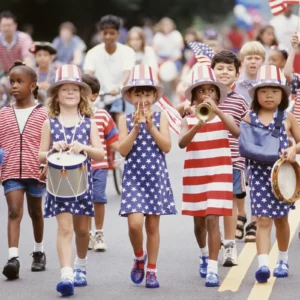The heart of America’s patriotism is Independence Day USA. Communities come to life on July 4 to commemorate the birth of the United States on July 4, 1776. It is full of red, white, and blue, and it is loud and proud. Parades fill the streets, backyard grills heat up, and fireworks explode in the night sky. But Independence Day is more than just a day for having fun; it also has a significant cultural and historical significance that makes it an important part of the American identity. It’s more than just a holiday—it’s a celebration of freedom, resilience, and the birth of a nation that changed the course of history.
Let’s dig into what makes July 4th so uniquely American, from its revolutionary roots to the way we celebrate it today.
The History of Independence Day
The Birth of a Nation: July 4, 1776
Independence Day USA traces its roots back to a bold and world-shaking moment in history. On July 4, 1776, thirteen American colonies, then under British rule, declared themselves free and independent states. This was more than just a legal requirement; it was also an act of rebellion against tyranny and a move in the direction of a new form of government that prioritized liberty over monarchy. Leading up to this day, tensions had been simmering for years. Colonists were fed up with British taxation without representation, restrictive laws, and the heavy hand of the crown. What began as peaceful protests escalated into armed conflict in 1775, sparking the Revolutionary War.
Then came the turning point. The Continental Congress gathered in Philadelphia and adopted the Declaration of Independence, primarily authored by Thomas Jefferson. In addition to announcing the United States’ separation from Great Britain, this influential document laid the ideological groundwork for the country by emphasizing democracy, equality, and individual rights. Though the war raged on until 1783, July 4, 1776, is remembered as the official birth of the United States of America. On that day, a vision of a nation governed by its citizens was realized.
Unique Ways to Celebrate Independence Day in the United States
Volunteering and Giving Back
Independence Day USA isn’t just about fireworks and parades—it’s a powerful moment to volunteer and strengthen communities. Many organizations use July 4th as an opportunity to host food drives, help veterans, or clean up post-celebration debris.
Charitable events—like park cleanups after fireworks—bring communities together while maintaining civic pride. Food pantries often organize Fourth of July food distributions to ensure all families enjoy the holiday. Veterans’ homes hold ceremonies where local volunteers assist with flag decorations or host BBQ events.
These acts of service embody the concept of freedom: it’s not just what we get—it’s what we give back. Volunteering during Independence Day builds solidarity and deepens civic responsibility. It’s a reminder that liberty thrives when we actively participate in our communities—linking directly to the spirit of American democracy (USAGov volunteer guide, Serve.gov).
Celebrating Independence Day USA in Big Cities
Families across the United States love adding personal touches to Independence Day celebrations. Here are unique ideas that mix fun, pride, and connection:
-
Patriotic Scavenger Hunt – Hide mini flags, star tokens, or red-white-blue treat vouchers around the yard.
-
DIY Craft Stations – Create tie-dye shirts in red, white, and blue; design patriotic wreaths or painted flower pots.
-
Firework Art Projects – Kids paint canvas designs that mimic bursting fireworks—safe, creative, and memorable.
-
Family History BBQ – Share stories of family members who served or immigrated, creating a personal narrative within the broader national history.
-
Community Storytelling Circle – Set up a storytelling session after dinner where neighbors share their experiences of freedom and belonging.
These interactive activities reinforce the meaning behind Independence Day: shared values, hand-made expressions of national identity, and family bonding rooted in American heritage.

Comparing Independence Day to Other Global Independence Celebrations
How Families Enjoy Independence Day USA
Independence Day USA boasts distinctive traditions shaped by American culture:
-
Fireworks Mania – No other country matches the scale or spectacle of U.S. fireworks shows.
-
Backyard BBQ Culture – Family gatherings centered around grills are uniquely American.
-
Patriotic Merchandising – The breadth of Independence Day decor and apparel—from temporary tattoos to themed tableware—sets the U.S. apart.
While other countries celebrate with military parades or flag ceremonies, the U.S. combines showmanship, civic service, and familial celebration in a distinctive blend. Localities—from New York City’s Macy’s Fireworks to rural small-town festivals—create a patchwork of celebration reflecting America’s regional diversity.
Shared Themes of Freedom and Patriotism
Despite differences in style, Independence Day celebrations across countries share core themes:
-
Freedom from Colonial Rule – Like the U.S., nations such as India (August 15), Pakistan (August 14), and Ghana (March 6) celebrate liberation from colonial powers.
-
National Symbols – Flags, anthems, and public ceremonies are universal expressions of unity.
-
Family and Community Events – Parades, festivals, and traditional food bring people together across cultures.
These similarities highlight a global narrative: independence is not just political emancipation—it’s an opportunity to reflect on national identity, collective values, and the promise of self-determination.
Challenges Facing Independence Day USA Celebrations in 2025
Political Polarization and National Identity
In recent years, political divisions have sometimes turned July 4th celebrations into a platform for protest or contrasting ideologies. Debates over which values best represent “America” unfold through demonstrations or symbolic flag burnings.
However, many events strive to keep focus on unity—hosting non-partisan concerts, multi-faith prayer services, or inclusive storytelling circles. These initiatives aim to reclaim Independence Day as a moment of shared belonging, rather than division. Local governments have stepped up, arranging inclusive ceremonies that emphasize common ground over discord.
Cultural Sensitivity and Inclusivity
Independence Day celebrations in 2025 are evolving to reflect America’s growing cultural diversity. Traditional events now include:
-
Multi-ethnic performances in concerts or festivals.
-
Invitations to indigenous groups to share their perspectives on freedom and land.
-
Dual-language ceremonies to honor non-English-speaking communities.
This evolving approach acknowledges that liberty is a mosaic—shaped by the stories of all Americans. As celebrations adapt, they increasingly embrace voices that were historically marginalized, striving towards a more inclusive national narrative.
Looking Ahead: The Future of Independence Day
Digital Celebrations and Changing Traditions
The digital age has transformed how we experience Independence Day. In 2025, online events and virtual engagement complement physical celebrations:
-
Live-streamed fireworks and drone-light shows bringing communities together across distance.
-
Social media campaigns showcasing hometown traditions, emphasizing local pride with #MyFourth in 2025.
-
Virtual museum tours and interactive timelines educating young people about American independence.
Hybrid celebrations allow those unable to attend in person—due to health, distance, or logistics—to experience the spirit. Technology creates new traditions while preserving the old—ensuring accessibility and participation for everyone.
Keeping the Spirit Alive for Generations

What lies ahead for Independence Day? Sustaining its meaning requires fresh approaches:
-
Civic education integration across schools, especially through collaborative programs with museums and veterans’ organizations.
-
Community mini-grants supporting small-town celebrations with inclusive programming and sustainable practices.
-
Green festival standards—firework-free zones, recyclable decor, and electric-themed light shows reducing environmental impact.
By focusing on education, inclusivity, and sustainability, America ensures future generations don’t just participate—they understand and uphold the spirit of freedom at the heart of July 4th.
Independence Day in the United States is more than fireworks—it’s a living, breathing expression of national identity. From historical roots to evolving modern practices, July 4 reflects American values: freedom, unity, interrogating progress, and celebrating diversity. By baking civic service, digital innovation, and sustainability into celebrations, we keep the flame of liberty bright for the centuries ahead.
Let July 4, 2025, be not just a party—but a pledge. To honor those who built the nation, engage in our communities, protect the planet, and include all who call America home. That’s how we truly celebrate Independence Day.